Cyber Resilience
An organization’s ability to prevent, detect,
respond to, and recover from cyber attacks with
minimal impact
Overview
Cyber Resilience is an organization’s ability to prevent, detect, respond to, and recover from cyber attacks with minimal impact. In the digital world, attacks are not a question of “if,” but “when.” Therefore, this pillar emphasizes infrastructure preparation, system resilience, and team readiness to face inevitable threats.
Referring to the NIST Cybersecurity Framework, Cyber Resilience involves five core functions: Identify (map assets and risks), Protect (protect systems), Detect (detect threats), Respond (handle attacks), and Recover (restore services). This approach ensures that the impact of attacks can be minimized, not just prevented.
With Cyber Resilience, organizations build a resilient culture: having contingency plans, incident response procedures, and the ability to recover quickly without losing public trust. This is not just a matter of technology, but also risk management, governance, and human resource readiness.
Key Component
Risk & Asset Management
Mapping critical assets, identifying risks, and determining protection priorities based on the impact on business and operations.
Zero Trust Readiness
The ability to apply the principle of never trust, always verify, which arises from a powerful combination of identity management (Cyber Privacy), data integrity assurance (Cyber Integrity), and multi-layered protection mechanisms.
Threat Detection & Monitoring
A continuous threat monitoring system, using log analysis, SIEM, threat intelligence, and real-time anomaly detection.
Incident Response & Recovery Planning
Strategies and procedures for responding to cyber incidents, mitigating the impact of attacks, and quickly restoring services with a tested plan.
Business Continuity & Backup Strategy
Service continuity is ensured through regular data backups, system replication, and a regularly updated BCP (Business Continuity Plan).
Security Operations (SecOps)
Operational security management, including SOC (Security Operations Center), vulnerability testing, and regular pentesting.
Patch Management & Secure Configuration
A systematic process for updating security patches, closing vulnerability gaps, and keeping system configurations secure.
Human Factor & Cyber Awareness
Building awareness and capabilities among teams and employees to recognize threats such as phishing and social engineering, and to report incidents.
Forensic Readiness & Evidence Collection
The ability to quickly gather legitimate digital evidence for forensic investigations, while also supporting legal proceedings if necessary.
Adaptive Security & Continuous Improvement
Continuously improve security posture by learning from incidents, the latest threat trends, and evaluation results.
Cyber Integrity Trustless Roadmap

Cyber Resilience Implementation Program
CRIP (Cyber Resilience Implementation Program) dirancang untuk membantu organisasi membangun resilience by design, melalui pendekatan berlapis yang menggabungkan teknologi trustless, layanan konsultasi strategis, cybersecurity operations, dan kolaborasi erat dengan perusahaan cybersecurity partner. Dalam program ini, Baliola bertindak sebagai strategic orchestrator yang memadukan kekuatan TraceTrust, MAC Fabric, dan vCISO Service dengan keahlian teknis partner di bidang SOC, pentest, threat intelligence, dan vulnerability management.
Program ini beroperasi dengan siklus Assessment → Consulting → Deployment → Re-Assessment, memastikan organisasi siap menghadapi serangan siber dan mampu meminimalkan dampak dari setiap insiden, dengan dokumentasi bukti audit yang transparan dan tidak dapat dimanipulasi melalui TraceTrust.
Assessment – Risk, Asset, & Vulnerability Analysis
- Cyber Resilience Maturity Assessment: Assesses the organization's position on the Trustless Maturity Matrix (0.0 – 3.0).
- Risk & Asset Mapping: Identifies critical assets (data, applications, infrastructure) and related risks.
- Vulnerability Assessment: Scanning security gaps on servers, applications, networks, and endpoints.
- Penetration Test (Pentest): Simulating attacks to measure system resilience. Security Baseline & Compliance Check: Evaluating compliance with standards (NIST CSF, ISO 27001, POJK).
- TraceTrust Integration: All assessment results are recorded immutably for audit evidence.
Consulting – Strategic Leadership & Blueprint Design
- vCISO Service:
- Provides a virtual CISO role to lead digital security policies, risk governance, and long-term strategy oversight.
- Serves as an executive advisor on cybersecurity-related decision-making.
- Resilience Blueprint: Designs comprehensive strategies (IRP, BCP, and Zero Trust Readiness).
- Threat Modeling & Risk Mitigation Plan: Identifies potential attacks and designs mitigation measures.
- Blue Team Advisory: Designing network, endpoint, and log monitoring defenses.
- Cyber Awareness Program: Employee training & attack simulations (red/blue team exercises).
- Policy & Governance Development: Drafting security policies, log governance, and data retention policies.
Deployment – Security Hardening & Trustless Infrastructure
- Network & Endpoint Hardening: Implementation of layered protection, network segmentation, and real-time monitoring.
- TraceTrust Platform: Blockchain-based audit trail for incident logging, patching, and remediation.
- MAC Fabric: Immutable log repository for incident evidence and integrity monitoring.
- Blockchain Explorer: Public audit facility for logs, security certificates, or compliance evidence.
- SOC & Threat Intelligence Integration: Integration with partner services (SIEM, IDS/IPS, vulnerability management).
- Awareness Campaign: Ongoing program for team education.
Re-Assessment – Continuous Testing & Improvement
- Repeat Penetration Testing & Vulnerability Scanning: Conducted periodically to assess the effectiveness of security controls.
- Post-Incident Review & Forensic Analysis: Incident evaluation, evidence documentation in TraceTrust, and strategic learning.
- Resilience Score Update: Measures maturity improvement in Trustless Matrix.
- vCISO Oversight: vCISO Baliola continuously monitors security posture developments and provides recommendations for improvement.
- Refresher Cyber Awareness Training: Advanced training based on the latest threat scenarios.
Reference
NIST Cybersecurity Framework (CSF) 2.0 – Framework utama untuk mengidentifikasi, melindungi, mendeteksi, merespons, dan memulihkan dari serangan siber.
NIST SP 800-61 – Computer Security Incident Handling Guide (prosedur respon insiden).
NIST SP 800-53 – Security and Privacy Controls for Federal Information Systems (kontrol keamanan dan ketahanan).
NIST SP 800-207 – Zero Trust Architecture (konsep arsitektur never trust, always verify).
ISO/IEC 27001 – Information Security Management Systems.
ISO/IEC 27035 – Information Security Incident Management (prosedur tanggap insiden).
ISO 22301 – Business Continuity Management Systems (rencana kelangsungan bisnis saat krisis).
CIS Controls v8 – Praktik terbaik untuk cyber defense termasuk deteksi dan respons ancaman.
MITRE ATT&CK Framework – Model analisis ancaman dan pola serangan siber.
UU No. 11 Tahun 2008 (ITE) dan perubahannya – Keamanan transaksi elektronik.
PP No. 71 Tahun 2019 – Penyelenggaraan Sistem dan Transaksi Elektronik (PSTE).
Peraturan BSSN No. 4 Tahun 2021 – Pedoman teknis perlindungan infrastruktur informasi vital (IIV).
Peraturan Presiden tentang SPBE – Sistem Pemerintahan Berbasis Elektronik.
Peraturan BSSN terkait Strategi Nasional Keamanan Siber.